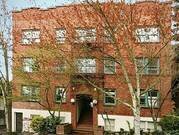 "much can be said" courtesy of our Flickr pool's +Russ
"much can be said" courtesy of our Flickr pool's +Russ
How is the Seattle real estate market like an ice cream cone? It's frozen and it either is currently "clearly a double-dipper" or will be. (Once again, Portland gets there first.)
Hell may have frozen over as well as Seattle; the Seattle Bubble says this could be a good time to buy a home. Granted, they're talking about prepared buyers taking advantage of that below-market deal they've found. Anecdotally, this is echoed by Redfin's report on the Seattle area market, which notes that a few first-time home buyers are making their move.
Otherwise, of the Seattle area homes pulled off the market in November, a full 60 percent were delisted by owners who plan to wait out the winter. Only 40 percent were sales. Of the city of Seattle 1,700-house November inventory (down 14 percent from October), 344 sold, while the time it took to close on a sale continued to lengthen thanks to difficulties finalizing financing.
Seattle condo sales remain way back in the deep freeze section, down a full 50 percent year over year. 137 sold, but 200 were delisted, to wait for spring. The Bubble warned that the home buying credit program was simply pulling demand from the future, and that once it ended, we'd see the frozen wasteland currently before us. But it is also true that many first-time buyers went the condo route, and now sit underwater, unable even to think of taking a short sale's loss; the average condo sale price per square foot is down just 1.2 percent from last November.
Meanwhile, bottom-callers have these home-price declines to stare at. (Here's the Bubble's latest Case-Schiller graphs.) It's not just Seattle, of course--Seattlepi.com reports that Seattle and ten other metro areas are seeing a "triple-dip," and analysts predict anywhere from another six to fifteen percent slide over 2011. (Nor is the problem limited to residential real estate--the Wall Street Journal reports that Beacon Capital Parters, owners of the Columbia Tower Center, are selling their best-performing asset to raise capital to meet debt obligations.)...
Weyerhauser just reported net earnings of more than $1.1 billion in the third quarter, which works out to $3.50 per share. That's exciting news for shareholders, in that it demonstrates conclusively that Weyerhauser's ongoing conversion to a REIT is a canny move. County and state officials might have a different take; the Wall Street Journal says REIT-sizing "should slash Weyerhaeuser's tax rate to nil as it tries to improve results."
It's the single most profitable thing that Weyerhauser has done over Q3, in that if you exclude the $1 billion booked for tax adjustments, per-share profit falls to $0.25. In terms of actual business, Weyerhauser's Cellulose Fibers division led the way, up $15 million in year-over-year profits, to $181 million total for Q3.
Otherwise wood products sales were affected by the weak housing market, said Dan Fulton, president and chief executive officer, adding: "The housing market also affects our Timberlands business, where we continue to defer harvest due to lower log demand." Weyerhauser warned that fourth quarter operating earnings are expected to be lower than the third, due to soft markets in all areas.
CNBC asked Governor Gregoire to respond to analyst Meredith Whitney's comparison of states to banks, pre-financial crisis. Here's what Whitney said in late September:
The similarities between the states and the banks are extreme to the extent that states have been spending dramatically and are leveraged dramatically. Municipal debt has doubled since 2000, spending has grown way faster than revenues.
Whitney said what reminded her most strongly of the banks' situation was the absence of "reliable data on state spending and debt."
Governor Gregoire chose to play off the phrasing, saying that, "We're in crisis mode. We the states are not in pre-crisis at all." That's no doubt true, but it evades Whitney's point that state spending and debt now represent a separate economic danger from the banks' credit meltdown, and that transparency is hard to come by. In fairness, Washington's credit rating is quite good, but with the caveats that a) if credit ratings were infallible, we wouldn't be in the crisis we're in, and b) things can change very quickly.
Gregoire noted that Washington has trade to rely on; unusually, we don't have a trade deficit with China. And state economists see mainly good news in that relationship for the future. Yet the state has to figure out how to avoid a $3 billion deficit over the next two years, and cuts have approached the bone. CNBC says:
In August, Gregoire announced plans for four- to- seven percent budget cuts across the board, as well as a phase-in of $51 million in cuts to state welfare aid. The cuts will disqualify nearly 2,500 families from child-care subsidies in October, and an additional 5,500 families from cash welfare benefits in February....
(more)
Between 1920 and 1960, Seattle grew from a backwater lumber town to a major center of manufacturing, retail, and commerce. The numbers tell the tale. In 1920, the population of Seattle was 315,000. By 1960, the city was 557,000 strong.
The rapid population rise was no doubt fueled by the rise of the aerospace industry leading up to and through World War II. But it was also fueled by a growing national awareness that the Pacific Northwest was a beautiful place to live with abundant water and wonderful access to nature, and was a nice base of jobs with growth potential.
It’s hard to imagine what living in Seattle was like in those critical four decades. There was no freeway, for one thing, but also no Seattle Center or Space Needle or professional sports stadiums. The tallest building in the city during those years was the Smith Tower.
It’s hard to get a feeling of the physical appearance of the city at that time by looking downtown; the landscape has simply changed too much. And historic photos don’t give you a sense of how people lived.
A great way to get insight into the life and times of the average Seattleite during those years, and to get a nice view of how the city expanded at the same time, is to take a tour of residential architecture.
The SunBreak Historical Architecture Team has plotted out a three street tour of three distinct mid-century neighborhoods in North Seattle....
 Flamingo chick at Woodland Park Zoo (Photo: Dennis Dow)
Flamingo chick at Woodland Park Zoo (Photo: Dennis Dow)
Via the Seattle Bubble (of course), let's point you to the Puget Sound Business Journal story on class action status granted to the Washington Mutual suit. While you're at the PSBJ, read this article on the double-dip in Seattle housing, and remember to buy your friends in the real estate business a drink. The Stroupe Condo Blog covers the last days of the McGuire Apartments.
In other news, State Supreme Court justices Richard Sanders and James Johnson made the Seattle Times for suggesting that while minorities end up in jail disproportionately (as part of the population), they do so under their own steam. Sanders helpfully clarified that certain minorities are "disproportionally represented in prison because they have a crime problem." (Also, things burn because they contain a "fire-like element.") Minority News has another angle.
Medical Teams International emailed us to say that a medical team of eight nurses from Washington state, assembled by North Shore Baptist Church in Bothell, has left to help with the cholera outbreak in Haiti. You sort of wish the epidemic hadn't been foreseen many months ago. In contrast, one of our big concerns is whether light rail is running on time.
RIP, flamingo chicks, we hardly new ye: "The two Chilean flamingo chicks that hatched this month at Woodland Park Zoo have passed away. The older of the chicks was found dead this morning in the exhibit, and the younger of the chicks was discovered missing Sunday night." And now...
Neighborhood Headline News...
 "FREE HOMES" courtesy of our Flickr pool's photocoyote
"FREE HOMES" courtesy of our Flickr pool's photocoyote
What's it all mean? The latest concern over messy mortgage paperwork injects more uncertainty into people's already uncertain lives. The Seattle Bubble reports "foreclosure notices are still rising rapidly year-over-year." FBR Capital Markets analyst Paul Miller says foreclosure delay losses could range from six to ten billion dollars. Any delay in processing will simply drag out the larger real estate market reset.
But the burning question once again--as with the subprime loan meltdown--is what the size of the problem is. Are these errors that can be corrected, or have lenders fast-tracked themselves into writing unsecured loans?
When I first heard that banks were halting foreclosures, I thought, naively, that they were attempting some kind of homeowner assistance program. But it turned out that banks have been illegally foreclosing on homeowners, through what's known as "robo-signing"or otherwise cutting corners.
In Washington state, Attorney General Rob McKenna says that investigators responding to complaints have found "inaccurate documents, conflicts-of-interest, faulty chains of title and failures to provide the disclosures and conduct mediations required by law." He's asked 52 Washington foreclosure trustees to suspend action on any "questionable" foreclosures....
"Buyers know that now is the time to get the big home with a view at a price that is hundreds of thousands less than just a couple of years ago, and at an incredibly low interest rate," says West Seattle Redfin agent Dan Mullins. He wasn't talking about condo auctions specifically, but he captures the appeal succinctly.
 For real estate market watchers, the auction is also a useful barometer. Over the weekend, 32 condos in the luxury condominium tower Olive 8 hit the auction block, and the results support those dismal few prognosticators who suspected, back in the boom days, that the market was overvalued by some 30 percent.
For real estate market watchers, the auction is also a useful barometer. Over the weekend, 32 condos in the luxury condominium tower Olive 8 hit the auction block, and the results support those dismal few prognosticators who suspected, back in the boom days, that the market was overvalued by some 30 percent.
Keep in mind, while perusing the Olive 8 sales, that this is what a luxury downtown condo goes for. Wendy Leung at Seattle Condo Review gives you a great by-the-numbers breakdown (with more granularity than you'll find in the Seattle Times Olive 8 auction story):
The homes were sold for an average of 66% of the previous listing price, which is very close to the average of the last few auctions (Queen Anne High School, Lumen, Brix, Gallery, and 5th and Madison) since 2009 at 67%.
Leung goes on to separate out high and low bids by condo size, and to work out their price per square foot. While the average discount from list price was 34 percent, a larger two-bedroom went for only 54 percent of list. The units being sold ranged between the 18th and 26th floors in the 39-story tower--the more expensive units above, over 100 unsold, have "price tags from $500,000 to $6.9 million," says the Seattle Times, who also make room for a cheery broker's quote:...
"Foreclosures continue to surge around Seattle," reports the Seattle Bubble, with King County's 1,413 notices of trustee sale in July representing an increase of 13 percent compared to July 2009.
 Thus this 410-sq.-ft. studio condo on East Thomas Street, just off Belmont on Capitol Hill, which the bank will let you have for $135,000. It's eligible for HomePath financing, so you can buy with just three percent down (about $4,000).
Thus this 410-sq.-ft. studio condo on East Thomas Street, just off Belmont on Capitol Hill, which the bank will let you have for $135,000. It's eligible for HomePath financing, so you can buy with just three percent down (about $4,000).
View the listing on Windermere or Redfin. It's a 1917 brick-exterior building, with natural gas and a heat pump. HOA is $252 per month, but property taxes are $1,617.
The price is down from an original $144,900 and it's been on the market for about a month and a half.
Redfin's July real estate summary compares buyers to vultures ("Vultures! Vultures everywhere!" Sorry. It's a tic.) who won't act until sellers pull the listing in despair, or someone else tries to snap it up. Sales volume is down, and inventory even ticked up slightly, as Seattle home sales dropped over 15 percent from June. Their spreadsheet shows 2,129 houses for sale in Seattle, and 1,373 condos. The median sale price for condos was $342 per square foot; for houses, $330.
Bottom line, says Glenn: "So far in August, we have seen record numbers of Redfin customers touring properties in Seattle, but buyers are very picky, and in no rush. Prices are going to stay down for the rest of the year, and probably longer."
Because of low clouds, the Blue Angels will be flying their "flat" program today and tomorrow.
You know what you don't hear very often? Good news about Bremerton real estate: "prices expected to increase 44.7 percent from 2010 to 2014."
It's official, La Nina this way comes, and, possibly, a cold, wet, snowy winter. If floods are an issue where you live, start planning now. This fall's work on the Howard Hanson Dam is timely. Senator Patty Murray got the dam repair monies tacked onto an appropriations bill, which I believe is the kind of thing Dino Rossi is against. Just FYI.
Sound Transit is scrambling to quell a ballooning projected deficit, says the Seattle Times. Seattle Transit Blog digs into the numbers.
Transit officials in Seattle consistently under-employ rider information aids, so it's not surprising that light rail station signs are just now beginning to tell riders where the train is going. When an light rail train accident took three hours to clear this week, "certain details, such as the length of delays, didn't make it to passengers." This is a light rail line that serves SeaTac airport, and which in its shake-down year is not experiencing "rare" delays so much as regular ones. But somehow ST's protocol for delays is to let passengers know last, if at all.
Let's go to the neighborhoods for more details on the week. Belltownpeople says au revoir to the Cinerama while it undergoes a two-month 3D upgrade. CHS is looking for witnesses to a public beat-down that happened as the Capitol Hill Block Party was getting started. A Blue Angels sonic boom got the residents of the Central District talking. Beacon Hill was invaded by Spain. RVP has a photo of that light rail v. truck accident....
 The Benaroya Companies are moving to the Eastside, reports the PSBJ. They're taking up residence in a 79,000-sq.-ft. Benaroya-owned building they've been working on refilling since Zango closed. The short story seems to be that it was easier to pick up stakes and move themselves than find someone to lease the last 8,300 sq. ft. Still, it's a portentous shift, given that Benaroya is the name of Seattle's symphony hall.
The Benaroya Companies are moving to the Eastside, reports the PSBJ. They're taking up residence in a 79,000-sq.-ft. Benaroya-owned building they've been working on refilling since Zango closed. The short story seems to be that it was easier to pick up stakes and move themselves than find someone to lease the last 8,300 sq. ft. Still, it's a portentous shift, given that Benaroya is the name of Seattle's symphony hall.
Meanwhile, mega-developers Schnitzer West have sold two major properties, notes Eric Pryne in the Seattle Times, Bellevue's Advanta Office Commons and Seattle's Equinox apartments née condos. (Equinox and Escala were among the last--if not the last--condo buildings to complete as the downturn shut off financing.) In both sales, Schnitzer West beat the properties' appraised value by wide margins--$75 million for Advanta, and almost $20 million for Equinox.
 And last week Target announced they were coming to Seattle's Pike Plaza, at the foot of the Newmark. Downtown residents rejoiced at the news, and if CHS polls are to be believed, Capitol Hill hipsters think it's just far enough away for them to retain credibility while slinking off-Hill for bargain-shopping.
And last week Target announced they were coming to Seattle's Pike Plaza, at the foot of the Newmark. Downtown residents rejoiced at the news, and if CHS polls are to be believed, Capitol Hill hipsters think it's just far enough away for them to retain credibility while slinking off-Hill for bargain-shopping.
 As you may know, I like to keep an eye on the motivated sellers on Capitol Hill, as a kind of market barometer. Here's a special case, likely due to financing.
As you may know, I like to keep an eye on the motivated sellers on Capitol Hill, as a kind of market barometer. Here's a special case, likely due to financing.
This one bedroom is on the second floor of a 1924 brick co-op near Seattle University, 1136 13th Ave. Redfin says it's been listed for over a year; Windermere has it selling originally for $175,000, now for $149,000.
It's 600 square feet, with a redone kitchen: granite countertop, slate floor. It comes with a stacked washer/dryer combo, and the HOA dues of $312 include earthquake insurance (because brick, see). It faces south, which is terrific, and there's a large walk-in closet. Downside, baseboard heat, not FHA-approved. I imagine that last is a sticking point for bargain shoppers.
With a 20-percent down payment, your mortgage and HOA could still be under $1,000 per month. And, you have to like the location. At 13th & Union, you're blocks away from everywhere you want to be (i.e., Café Presse and Stumptown, Piecora's, the Pike/Pine corridor, Pony...really, anything fun that begins with "P"). Assuming it doesn't fall down around your ears in the Big One, you're in a good spot.
Escala's news release last Wednesday reported 65 new sales, with 38 closings, in the last three months. That's 38 of a total of 275 units, after the condo tower reopened with prices reduced 20 to 50 percent at the end of March. (Last February, the PSBJ was reporting that only six units had sold, and current King County tax records show just eleven units in private ownership.)
Designed by Thoryk Architecture (Mulvanney G2 were architects of record, and DiLeonardo International, Inc., did the interior design), the 30-floor, $370-million tower from developer Lexas Companies has come down in the world since 2006, when you could "reserve a home" with a $10,000 deposit. (Urbnlivn took the video above, and wrote a review, after touring an open house.)
The idea was to overwhelm Seattle's highest-living with luxury amenities, including a "spa, library, billiard room, theatre/screening room, fitness center with a lap pool, a catering kitchen, a formal dining room, and an events center." There was a marble staircase at the entrance, of course.
In 2007, as the Seattle Times reported, it was the "year of the condo" in Seattle: "Real-estate economist Matthew Gardner shared Thyer's optimism, telling an audience of about 700 that demand for new places to live downtown will remain 'very positive.'"...
Our analyst, keeping an eye on the market.
Redfin has their monthly state-of-the-market real estate report out, and the headline is "Prices Up, Fundamentals Down" (for June compared to May). By "up," they mean a 1.7 percent price increase, and by "down" they mean inventory grew five percent, in tandem with the number of houses sold dropping two percent.
While sellers weren't budging on price--last month--a Redfin agent says owners taking on thousands of dollars in post-inspection work is becoming more common.
In Seattle, inventory increased by double-digit percentages in Maple Leaf, Queen Anne, and Ravenna. Pickings are much slimmer in Capitol Hill, Magnolia, and Greenwood. Seattle's median home price ($450,000) was down negligibly from May, 1.4 percent, and showed no change from June 2009, at $334 per sq. ft. That varies appreciably in-city: Queen Anne is $445 per sq. ft. and Beacon Hill is $248 per sq. ft.
Perhaps not coincidentally, the slight drop in Seattle's median was the result of increased sales volume in areas like West Seattle, where the median dropped about eight percent.
If it's condos you're looking for, Redfin shows almost 3,000 units for sale in Seattle; the lowest median list price is in Rainier Valley, at $133,000. For contrast, the median around Pike Place is $650,000. The median list for Capitol Hill condos is down almost 15 percent from June 2009.
Last week, Redfin CEO Glenn Kelman was quoted by CNBC's Diana Olick, saying:
The real estate market is like a fat man that can't get up. The U.S. government has modified loans, extended tax credits, lowered interest rates; we've fired a lot of our guns, and at this point the market is just going to have a long slow period of decline.
(Kelman is good with quotes: "I've sometimes wondered if God calibrated the size of our brains and the amount of fuel in the sun to give us just enough time to figure out the universe & send a space-ark toward a new galaxy, but the only guys who could figure this out are working for Wall Street.")
This is the kind of wry observation that appeals to skeptical inquirers like Seattle Bubble, who have applauded Redfin's entry into monthly real estate data reports: "Redfin has taken a page from the NWMLS playbook, torn it out, shredded it, burned it, flushed it down the toilet, and written a whole new book from scratch on the subject of monthly data releases."
Full disclosure: the Bubble's Tim Ellis contributes to Redfin's "Sweet Seattle Digs" blog, but this would only seem to add to Redfin's credibility, since the Bubble's readership is, if anything, more critical than Ellis, and would probably turn on him in minutes if he slipped up. (In this I seem to disagree with 360Digest's Marlow Harris, who couldn't see any point to noting real estate was over-priced, back in November 2008, and questioned Redfin's viability. She will have to wait a bit longer for Redfin to fail.)
But Redfin's credibility isn't simply derived from a refreshing bluntness. Old school real-estate watchers often sound like they have a crystal ball secreted away somewhere--they employ the astrologer's and psychic's tools of saliency and confirmation bias. They are exquisitely sensitive to the "mood" of the market, so far as ad hoc rationalizations go. In the absence of a testable, fresh-data-driven model, there's a tendency toward superstition and making bets. (As Dan Ariely points out, our intuition works best when drawing on observable cause-and-effect, throw in a time-delay and we're mainly guessing.)...
 This week's wow-look-at-that-price selection is from the unfortunately named Maison Jiselle development at 14th Ave. and Yesler: a one-bedroom that at 139,000 could give you mortgage payments of less than $1,000 a month (FHA-approved, HOA $161, taxes $1,371).
This week's wow-look-at-that-price selection is from the unfortunately named Maison Jiselle development at 14th Ave. and Yesler: a one-bedroom that at 139,000 could give you mortgage payments of less than $1,000 a month (FHA-approved, HOA $161, taxes $1,371).
Seattle Condo Review says it's a 16-unit conversion project (the 1928 original construction got the usual upgrades in electricity, plumbing, and windows), and notes the location is "pretty close to Seattle University, the International district, and Capitol Hill." Dan Ariely says the most important question you can ask about a new home is who you want your neighbors to be, so read up on the Central District.
It's a "very walkable" location, says Walk Score, 82 out of 100. Your bar is Waid's and your movie theatre is Central Cinema. Besides, something called the First Hill Streetcar will be two blocks from your front door, if you don't feel like walking beginning 2013.
People who have visited say unless you choose to wear wide-angles contact lenses, you will find the "very efficient" 480 sq. ft. to be somewhat less visually dazzling than the photos would have you believe. (I love how convenient the laundry is to your bedroom laundry basket.) No parking, no storage unit, but the units overlook an "English garden" courtyard.
The good news is that my phone expects the temperature to reach 78 degrees today. Let's focus on that for a moment. On Monday, the clouds should be back, and the city will be announcing budget cuts.
Friday afternoon brought another bank seizure by government regulators: Washington First International Bank was sold to Pasadena's East West Bank, reported the PSBJ. Commercial real estate gone bad. That would seem to make Jon Talton's Friday morning post about the possibility of a Seattle commercial real estate crash required reading. Goldman Sachs thinks our residential real estate is about lose 20 percent in value, so maybe put the money back into the mattress.
Lots of transportation news this week: a federal judge said "Oh hell no" to Patty Murray's attempt restore King County Metro special service to Mariners games. Metro is also gearing up for union negotiations by releasing incomplete information on bus operator compensation (and ignoring media requests for a fuller picture). And the King County Ferry District would like you not to notice that Argosy Cruises ran the West Seattle Water Taxi for cheaper....
Windermere has a Capitol Hill condo selling for $149,000 down the street from The SunBreak offices, at 1125 E Olive (at 12th Avenue). It's 436 sq. ft., hardwood floors, forced air, HOA is $200. It's the lowest-priced condo on my email update by far, with $40,000 between that and the next listed price. But if it's snapped up before you can put down an offer, stay cool.
Whether you call it depreciation or affordability, Goldman Sachs says the next two years should bring more of it; Seattle Bubble (naturally) spotted their prediction that Seattle home prices would lead other major U.S. urban areas with a 22 percent decline over the next two years.
Goldman Sachs calls our situation a "back-loaded price decline," which has a familiar ring to anyone familiar with Seattle Bubble's time-adjusting housing price graphs. Las Vegas and Portland join us in home devaluation "due to high homeowner vacancy rates and/or rising mortgage delinquencies," but Seattle is way out down in front, losing ten percent more in value than Portland over the next eight quarters....
Earlier this week I was up at Northgate, and decided to drop in at the Thornton Place complex for the first time. I've been interested in the area ever since Seattle Public Utilities mounted a restoration project for Thornton Creek, which, fed by over 11 square acres, drains into Lake Washington. In former days, the creek had salmon and trout.
The creek has been daylighted, and its banks are coating themselves with greenery, but Thornton Place remains caught between the future its developers (Stellar and Lorig) hoped for and the recessionary one that appeared.
While apartments are renting, some 20 of the condos, which were not selling like hotcakes in the cooling housing market, developed a settling problem that was announced in early April 2010. Today, the 109 condos sit there, empty, aging, and waiting for the other shoe to drop. They're not Lorig's only problem.
In the meantime, Stellar is still looking for commercial clients for its retail space in the complex--they'd love a brewpub, and are considering hosting a farmer's market. And it's not precisely a ghost town: Regal Thornton Place, notes the Seattle Times, is raking in $17.50 per ticket for Shrek 3-D in IMAX.
But there's no denying the feeling you've stumbled onto the set of Life After People when you walk, all by yourself, down the promenade, to your right a revitalized creek pooling and tumbling over rocks, and to your left bare granite-top counters, one after another. Sooner or later, something's got to give.
"VERY URBAN" is the title of this shot of the formerly-known-as-WaMu tower by photocoyote.
Colliers International has released its spring "knowledge report," looking back on Q1 and forecasting for the year ahead. The good news for Seattle is simply that no new commercial real estate came on the market in the first quarter, so the vacancy rate for the year-to-date, about 17.7 percent, remained the same as 2009. (Next quarter brings the opening of 505 First Avenue, with almost 290,000 sq. ft. added to the 1 to 1.5 million sq. ft. available.)
For now, landlords are holding the line on their offers and concessions to new tenants. But every month that goes by with an almost-20-percent vacancy rate represents a drag on the economy. A lot of mortgages out there were written dependent on rental income that's dropped precipitously. (See Beacon Capital Partner's claim that its rents now cover just 20 percent of its debt obligations.)
So Colliers' optimism about the housing and stock markets looks a little less persuasive at this precise moment. Here's their take:
With the residential housing market continuing to gain strength and the Dow Jones Industrial Average up nearly 4,500 points to its 19 month high (currently above 11,000), all signs point to positive economic growth.
Yet the Wall Street Journal reports that Chicago's unofficial "fear index" has jumped 18 percent following this week's market dive. Jon Talton at the Seattle Times notes that while the proximate cause may be concerns about Greece's sovereign debt, the market run-up has been driven by bail-outs (literally, and indirectly, in the form of low, low interest rates).
Seattle Bubble has been keeping tabs on the residential housing market, and while there's been the usual spring flurry of sales, take a look at the second graph here, the next time someone mentions a "strong recovery."
The Puget Sound Business Journal dug into King County foreclosures, and found that Seattle is, anomalously, still reporting increases in foreclosure-related "distressed sales: "By June, it’s estimated that more than 800 homes will be scheduled for auction in any given week. That’s up from an average of about 40 auctions a week in 2006 and 2007. Many of the homes don’t sell at auction." (About two-thirds of the foreclosures they tracked last year didn't sell.)
Photo: Ryan Hawk/Woodland Park Zoo
The meerkats are coming! May 1 is the date for their cute blitzkrieg on the Woodland Park Zoo.
Eight Rikki-Tikki-Tavi relatives will take over a newly renovated exhibit in the zoo's Adaptations Building. They've been away for ten years, and now they're returning to settle old scores by zooming along tunnels or poking their heads out curiously with their WIDDLE NOSES!
Now, back to hard-nosed news. Underwater? Scrambling to pay the mortgage? If only you could "strategically default," like the owner of the Columbia Tower, plus nine other office towers and buildings in Seattle and Bellevue, as reported in the Seattle Times.
With office rents plummeting due to an almost 20 percent vacancy rate in Seattle, Beacon Capital Properties says its rental income covers (after expenses) covers only 20 percent of its loan payments.
The Teamsters threw an on-again, off-again strike to protest Waste Management, Inc., raising their share of health insurance costs. You'd think garbage collection was a stable revenue stream, but I checked WMI's annual report and revenue fell about 15 percent last year. You know what didn't? Health insurance costs.
Down at City Hall, the Mayor vetoed the anti-aggressive-panhandling bill, after a 5-4 City Council vote in favor. All nine members of the Council signed on to a firmly worded letter to the Mayor, asking him to lift a hiring freeze on new police officers. McGinn, on KUOW, said the Council had passed an unbalanced budget. (Nyah, nyah.) So that's going well. Image-wise, everyone comes out wearing the same size clown shoes. In the meantime, here's SeattleCrime.com's map of where you can go to get robbed.
In other testy government-epistle news, the Sustainable 520 Coalition sent a letter to the Governor laying out the grounds for redesigning 520's replacement to carry light rail from day one. Washington's rich people have had it with the spineless legislature! If they won't pass a high-earner's income tax, they'll do it by initiative. If BNET's crystal ball isn't cracked, we're incubating a substantial increase in new jobs over the next ten years. Group Health Credit Union is changing its name to Salal Credit Union. Huh....
Yes, it's a fixer-upper. It's in a co-op. And it seems to be named after a down-market school. But at $109,000, it's like the time travel machine worked and we've landed back in the 1990s.
Your one-bedroom hideaway just north of Pine Street on desirable 15th Ave is 541 sq. ft., there's what looks like a claw-foot tub, and you get radiator heat. Oh, the luxury. The kitchen is Lilliputian. No getting around that. But with Teriyaki Madness and Zaw Pizza just flip-flop distance away, when will you be cooking anything besides toast?
Of course I'm right. Now get out there and make an offer. There's never been a better time to buy!
UPDATE: Matt Goyer found actual listings for you to choose from: Redfin, Windermere, and John L. Scott.
 Slightlynorth gives you...Belltown!
Slightlynorth gives you...Belltown!
(Follow-up post on the architects, structural engineers, and general contractor here.)
The McGuire apartment building, at 210 Wall Street in Belltown, opened its doors in 2001. Now, just nine years later, it's closing them for good. Though the marketing copy, ironically, boasts "exceptional attention to detail in design construction," the 25-story building, with 272 units, is suffering from "corrosion of post-tensioned cables and concrete material and reinforcement placement deficiencies," according to legal real estate advisers Kennedy Associates. (Their full press release, with full grout details, is after the jump.)
Since repair is financially infeasible, residents are being relocated (with larger incentives the sooner they leave), and the building will be dismantled. Everyone must go by the end of this year. This comes as a bit of a shock to residents of the upscale building, who are paying $1,000-$1,500 per month just for studios. But investigation of the defects revealed that conditions were becoming unsafe, and Seattle's Department of Planning and Development is requiring the building's owner to submit periodic inspection reports to track the building's health.
Carpenter’s Tower, LLC, is the named owner, a partnership of the Carpenters Union, Local 131, and MEPT, the Multi-Employer Property Trust. They're suing the general contractor and architects (not named in the news release). Since it's unlikely the general contractor built just one structure, I've got a call in to find out who it was.
In the heyday of building before the real estate market crashed, roughly from 2001 onward, just-add-water condos sprouted up quickly. Nine years was enough to do The McGuire in--that doesn't seem that long. But the Seattle Times just reported on Northgate's Thornton Place condominiums, and the settling problem that 20 of the 109 units are experiencing, just a year after project completion. Floors and walls have separated by half an inch so far....
Remember those heady days when corporate honchos were so afraid of the wrath of their shareholders they canceled spendy retreats at 5-star resorts? Those days are gone, of course.
Now Seattle real estate investment firm Washington Holdings, owners of One and Two Union Square, have bought AIG's Orange County resort getaway, St. Regis Monarch Beach. (A few days after receiving $85 billion in bailout money, AIG executives dropped $443,000 on a week-long "conference" at St. Regis.)
It might seem an odd time to buy in, but it doesn't seem like they had much choice. The Los Angeles Times reports that in 2007, the previous owners of St. Regis refinanced, leaving Washington Holdings and Prudential holding a senior mortgage of $230 million. Citigroup held a secondary mortage for $70 million, which was defaulted on first, so they initially took ownership with the obligation to make payments on the senior mortgage.
Now Citigroup has handed over the title to Washington Holdings with a hearty "Good luck!" The Times says "people familiar with the deal" put the value at $235 million. That's either a good way to avoid writing down a decline in value of $100- to $200 million by avoiding a public sale, or canny investment in a market about to bounce back, depending on who the Times talked to.
"The bottom line is that this hotel had too much debt on it and otherwise is a perfectly viable, successful and amazing property," said Craig Wrench, chief executive of Washington Holdings.
As California's only five-star, five-diamond coastal resort with a full golf course, the St. Regis is "a special property," said hotel industry investment banker Don Wise of Johnson Capital. "It just got clobbered with so many ill effects of the economy that debt became problematic."
"Tourist," a view from the Columbia Tower, courtesy of The SunBreak Flickr pool's slightlynorth.
It was a week featuring two of Seattle's most prominent architectural icons: on the tenth anniversary of the Kingdome implosion, the market for commercial space downtown has imploded, too. Beacon Capital Partners missed a loan payment on the Columbia Tower, and faces a 33 percent vacancy rate once Amazon decamps next year. Starbucks announced ten-cent-per-share dividends at its annual meeting. One of our hippos died.
Plans for a private Chihuly exhibit at Seattle Center ran smack into Seattle process; now the Center will open up public bidding for use of the space vacated by the Fun Forest. Seattlepi.com reports that "Beth Campbell filed a motion in U.S. District Court asking that construction of the southern mile of a viaduct-replacement project be delayed until a full environmental-impact study is done of the entire viaduct project."
The city council joined every other Washington Democrat in wishing AG Rob McKenna would not challenge the constitutionality of the federal health care reform bill. Seattle's direct care providers Qliance are looking forward to the new insurance exchanges. Seattle was named the top city for cybercrime in America.
Mayor McGinn claims he has an affordable West Seattle-Ballard light rail line up his sleeve. Amtrak passengers had to take the long way around when a mudslide hit the tracks near Mukilteo--for the second time in two weeks. Mudslides aside, we now have extra Amtrak to Vancouver, B.C., through September. Nick Licata wants to lean on the U.S. Army Corps of Engineers for help with the seawall replacement....





Most Recent Comments